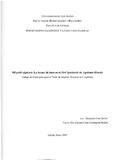He prole ekphorá: La forma de base en eI Perì Synlaxeos de ApoIonio Díscolo
Fecha
2011-01-12Autor
Palabras Clave
Léxico, LingüísticaLexicon, Linguistics
Metadatos
Mostrar el registro completo del ítemResumen
El presente estudio tiene por objetivo rastrear la noción de estructura profunda propuesta
por Chomsky en el Perì Synlaxeos de Apolonio Díscolo. Para ello se realizo una revisión
teórica sobre la noción de estructura profunda en las principales obras lingüísticas de
Chomsky, con la finalidad de observar su evolución dentro de los desarrollos teóricos de la
gramática generativa. Asimismo, siguiendo las pautas que Householder propone en su
traducción del Perì Synlaxeos, se llevo a cabo una lectura minuciosa de dicho tratado, tanto
en lengua original como en traducciones al español e inglés, con el objetivo de confrontar
las diferentes propuestas exegéticas del texto. La lectura del Perì Synlaxeos demostró que,
efectivamente, es identificable una noción de estructura sintáctica mas abstracta encargada
de la pre-configuración de las unidades para la final emisión de enunciados. Dicha noción
se ve reflejada no solo a nivel teórico sino a nivel léxico mediante expresiones como prote
ekphorá o prote thésis, y verbos como apoteleo y lemmatízo. De igual forma, se pudo
comprobar la presencia de la idea de transformaci6n en el léxico empleado por Apolonio en
el Perì Synlaxeos: sustantivos como metalepsis y verbos como metalambámo ponen de
manifiesto esta idea dentro de su teoría sintáctica.
Información Adicional
| Resumen en otro Idioma | The main purpose of this study is to trace the notion of deep structure proposed by Chomsky on the Apolonius Dyscolus ' Perì Synlaxeos. In order to do so, a theoretical review of the notion of deep structure was done on Chomsky's main linguistic works to observe its evolution on the generative grammar theory. At the same time, the guidelines proposed by Householder on his Peri Syntaxeos English translation were followed and a thorough reading was done of this treatise in its original language as well as in its English and Spanish translations-all of this in order to confront the different interpretations of the text in question. The reading of Perì Synlaxeos proved that there is indeed a notion of a more abstract syntactic structure in charge of pre-configuring all the elements for the final emission of utterances. This notion is present not only at a theoretical level, but also at a lexical one through expressions such as prOle ekphora or prOte thesis, and verbs like apoteleo and lemmatizo. Likewise, it was established that the idea of transformation is also present in the vocabulary used by Apolonius in his Perì Synlaxeos -nouns like metátlepsis and verbs such as metalambáno show this notion in his syntactic theory |
| Grado | Maestría |
| País | Venezuela |
| Institución | Universidad de Los Andes |
| Tutores | Domínguez Mujica, Carmen Luisa |






